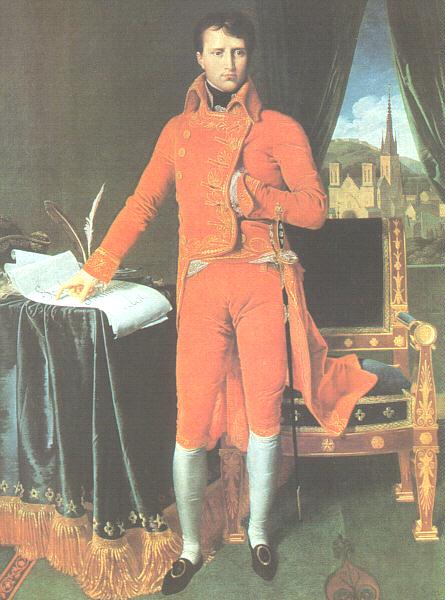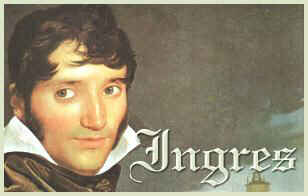— Calling
of the First Apostles (1481) _ Domenico represented Christ calling
Peter and Andrew from their nets, and, above the door, the Resurrection
of Christ, which later vanished completely in the destruction of the
wall. The Calling of the First Apostles was certainly a considerable
undertaking and Ghirlandaio here takes on a solemnity that is unequaled
either before or after. In some expressions, such as that of the sober Christ
or the adoring look of the two who are summoned, we are reminded of Masaccio
and his Tribute
Money. Ghirlandaio's distinctive style is expressed in the group
of talkative women on the left, and the curious peeping glances of those
who want to see, and, perhaps, be seen. The extensive, evocative landscape
contains trees, water, and undulating hills that fade into the distance.
In the painting Christ appears three times. In the background on the left
he twice stands on the shoreline and on each occasion calls two fishermen,
with the words: "Follow me, and I will make you fishers of men." On a third
occasion, standing in the foreground, he blesses the kneeling brothers Simon
Peter and Andrew. In the Roman fresco the colors are vivid and radiant,
caressing the delicate flesh tones, the various shades of the solemn robes
and fashionable clothes of the young. _ Detail
at left _ The group of women on the left side of the fresco, including
a woman in blue seen from behind, anticipates the female figures Ghirlandaio
paints in later works. _ Detail
at right _ Ghirlandaio comes into his own in the group of characters
on the right, who are all, real portraits. Represented here are the most
important components of the large Florentine colony in Rome — figures
belonging to the most illustrious families of the city who had opened branches
of their Florentine businesses in Rome, but above all the representatives
of the Medici House banks of credit and commerce. Giovanni Tornabuoni (whose
sister was the wife of Piero de' Medici) figures prominently among the other
characters portrayed. Head of the Medici Bank in Rome, he was so expert
in financial and business affairs that he became the treasurer of Sixtus
IV. Tornabuoni now is elderly, or so it would appear from his austere countenance
and the deep wrinkles that furrow his brow and temples. Lorenzo, still almost
a boy, stands in front of his father, his sad face revealing a certain feminine
softness. Further along the line, in profile, possibly another Tornabuoni
is portrayed, the noble and cultivated Cecco. The character on the far right
of the group is a member of the Vespucci family, Giovanni Antonio, whose
sharp profile is illumined by a bright light that seems almost to lend him
the suggestion of a smile. Another bareheaded gentleman, with white hair
and a pensive expression is thought by some to be the Florentine Francesco
Soderini. Argyropulus is also among the Florentines, the old man with the
resentful expression and rather weak face framed by a short white beard,
and with his head covered by a strange, hard, almost prelatic hat. The Greek
John Argyropulus, born in Constantinople but driven out by the Turks in
1453, had found refuge in Florence, in the cultivated circle of the Medici,
whose guest he was for fifteen years. He had held the professorship of Greek
at the university of Florence and Lorenzo il Magnifico had made him a citizen
of Florence, which had become the city of his choice. When Argyropulus was
called to Rome by Sixtus IV, he continued to regard himself as a Florentine
and as such, with the others, Ghirlandaio portrayed him.
— Decoration
of the Sala del Gigli (1484) _ In 1482 Ghirlandaio received the official
commission from the Signoria, the city government, to produce the decorations
in the Sala dei Gigli in the town hall, the Palazzo Vecchio. Sandro Botticelli,
Perugino and Piero
del Pollaiolo had also been assigned to the task, but only Domenico
accomplished the undertaking. The most important consideration in the Sala
dei Gigli was that the overall effect had to be magnificent, and the purpose
of the monumental public work was to express the pride of the city and Republic
of Florence. Ghirlandaio divided one wall by means of painted pilasters,
with three arches between them. The two outer arches are over a doorway
and a blind window. The result is that the entire wall appears as a mighty
triumphal arch. In the center is Saint Zenobius, the patron saint of Florence,
with two saintly deacons. In the tympanum above the bishop is a terra-cotta
relief of the Madonna and angels, a work similar to many that were produced
by the workshop of the Della Robbia family of artists. In the background
on the left there is a view of Florence Cathedral. Under the side arches
stand historical characters who embody civic and republican virtues. In
these figures Ghirlandaio produced very detailed variations of Roman armor
and the classical contrapposto postures, features portrayed with considerable
archeological accuracy. In the Sala dei Gigli the pictorial scheme is grandiose
and the ancient figures depicted in the higher part of the fresco have an
extraordinary energy. The deacons in the center, on the other hand, are
weak, rather limp and monotonous, even in the colors, which have lost their
original brightness and luster. This work is not of a high quality. Already
occupied with the Sassetti Chapel, which probably gave him more satisfaction,
in the Sala dei Gigli he probably traced the outline of the painting only,
leaving a large part of its execution to assistants. In addition to his
two brothers David and Benedetto, and his brother-in-law Bastiano
Mainardi, there were many other assistants: Bartolomeo
di Giovanni, Francesco
Granacci and Biagio
d'Antonio di Firenze. It is impossible to attribute the responsibility
to this or that assistant for the inferior parts of Ghirlandaio's fresco
cycles, since he was also responsible for the parts that lack the animated
style, vitality and mastery of color that were present in others. From these
sometimes considerable discrepancies we must form a judgment about his work
that makes him at once a marvelous interpreter of people and situations,
a calm, almost monotonous narrator, or a tired and empty artist at times
in search of the best, at others yielding to a commonplace routine._ Detail 1
_ Under the side arches stand historical characters who embody civic and
republican virtues. In these figures Ghirlandaio produced very detailed
variations of Roman armor and the classical contrapposto postures, features
portrayed with considerable archeological accuracy. On the right Decius,
Scipio and Cicero are depicted. _ Detail
2 _ Under the side arches stand historical characters who embody civic
and republican virtues. In these figures Ghirlandaio produced very detailed
variations of Roman armor and the classical contrapposto postures, features
portrayed with considerable archeological accuracy. On the left Brutus,
Mucius Scaevola and Camillus are depicted.
|
 ^
Died on 14 January 1867:
^
Died on 14 January 1867:  Jean Auguste Dominique Ingres was a French painter who was a leading figure
in the neoclassical movement. Ingres was the son of an unsuccessful sculptor
and painter. He entered the studio of the neoclassical painter Jacques Louis
David in Paris in 1797 and won the Prix de Rome in 1801 for his painting
The Ambassadors of Agamemnon.
Jean Auguste Dominique Ingres was a French painter who was a leading figure
in the neoclassical movement. Ingres was the son of an unsuccessful sculptor
and painter. He entered the studio of the neoclassical painter Jacques Louis
David in Paris in 1797 and won the Prix de Rome in 1801 for his painting
The Ambassadors of Agamemnon.